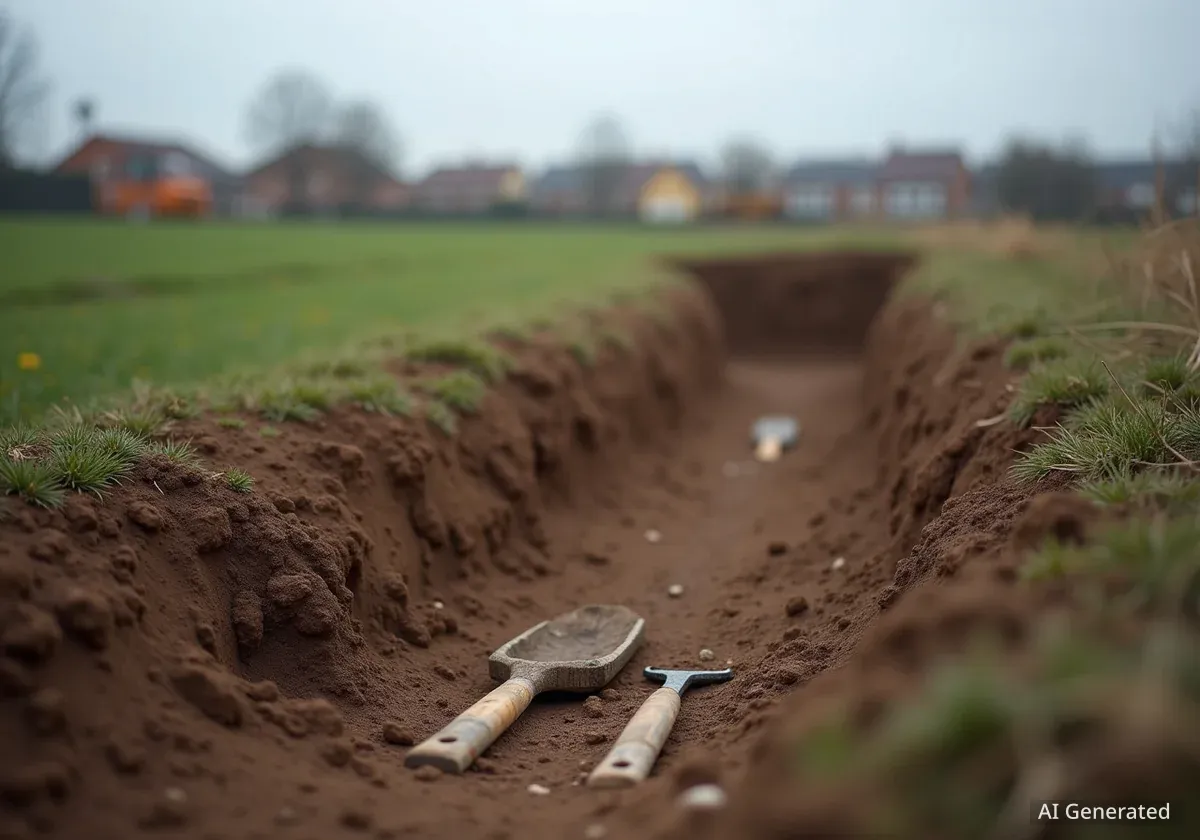A planned housing development on the site of a former school in Formby is contingent on the completion of a detailed archaeological survey. Redrow Homes Limited has received approval to build 89 new dwellings on the land previously occupied by Clarence House school, but work cannot begin until specific planning conditions, including an investigation for historical remains, are met.
The site on West Lane has been vacant since the school's closure in 2018. The mandated archaeological work includes a clear protocol for the potential discovery of human remains, a standard precaution for developments on land with a long history.
Key Takeaways
- A housing development of 89 homes is planned for the former Clarence House school site in Formby.
- Sefton Council has mandated a full archaeological survey before any demolition or construction can start.
- The survey includes a Written Scheme of Investigation (WSI) with strict protocols for handling potential historical artifacts, including human remains.
- The school, previously run by Nugent Care, closed in 2018 and the site has remained derelict, experiencing two fires.
Development Plans for the Former Clarence House
The site of the former Clarence House school, located on West Lane in Formby, is set for a major transformation. The school, which provided education for pupils aged seven to 19, was closed in 2018 due to what its owners, Nugent Care, described as 'financial pressures'.
For the past seven years, the buildings have been abandoned and have fallen into disrepair. The derelict site has been a point of local concern, particularly after two fires were reported, one in 2023 and another on September 11, 2025.
Developer Redrow Homes Limited submitted a planning application in September 2023 to demolish the existing structures and construct 89 new homes. Following a review by Sefton Council's planning committee in December 2024, final approval for the scheme was granted in May 2025.
Site at a Glance
- Location: West Lane, Formby, Merseyside
- Previous Use: Clarence House school (closed 2018)
- Proposed Development: 89 new dwellings
- Developer: Redrow Homes Limited
- Status: Planning permission granted, subject to conditions
Archaeological Survey Mandated by Council
Before any demolition or construction can commence, Redrow Homes must fulfill several pre-commencement conditions set by Sefton Council. One of the most significant requirements is the completion of a comprehensive archaeological investigation.
The specific condition states that no development can occur on the eastern part of the site until a programme of archaeological work is completed and a report is submitted. This work must follow a detailed plan known as a Written Scheme of Investigation (WSI).
This WSI had to be submitted to and approved by the local planning authority before any site work could be considered. According to council documents, this step is a standard requirement to ensure that any potential historical or archaeological significance of the land is properly assessed and recorded.
Why Are Archaeological Surveys Required?
Local planning authorities often require archaeological assessments as a condition of planning permission, especially for sites with a long history of use or those located in areas of known archaeological interest. This process ensures that any buried heritage is not lost during construction and is properly excavated, recorded, and preserved if necessary.
The Written Scheme of Investigation
In July, Redrow Homes' agent, White Peak Planning (WPP), confirmed in a letter to Sefton Council that the WSI for the archaeological evaluation had been submitted. This document outlines the methodology for the investigation.
The primary goal of the archaeological work, as stated in the WSI, is to conduct trial trenching to "determine the presence or absence of buried archaeological remains within the site." This process helps archaeologists understand the history of the land before it is permanently altered by new construction.
WPP noted that submitting the WSI is only the first part of fulfilling the condition. The full requirement will be met only after the approved archaeological fieldwork is finished and the findings are reported back to the council.
Protocol for Potential Human Remains
The WSI contains specific and stringent procedures for the event of discovering sensitive materials, with a dedicated section on human remains. This is a standard inclusion in archaeological plans to ensure any such findings are handled legally and respectfully.
The document outlines a clear course of action. Should any remains be found, all excavation work in the immediate area must stop instantly.
"Upon the discovery of sensitive material (e.g., human remains or particularly significant features), all excavation shall cease, and the archaeological contractor will establish a clearly visible cordon around the area of discovery, to ensure protection from exposure, accidental damage and / or theft."
The protocol also mandates immediate communication with authorities. The plan specifies that in the event of discovering human remains, whether burials or cremations, the local police and the coroner must be informed without delay.
Further steps include:
- Screening the area from public view.
- Discussions with the developer and archaeological advisors on how to proceed.
- Options include preserving the remains in their original location (in situ) or careful removal by professional standards.
The document also clarifies a crucial legal requirement. "In the event of human burials being discovered, a Ministry of Justice Licence will be required before the remains can be lifted," the WSI states. This applies to both buried and cremated remains and is a necessary legal step before any disturbance can occur. Redrow Homes Limited was contacted but chose not to provide a comment at this time.





